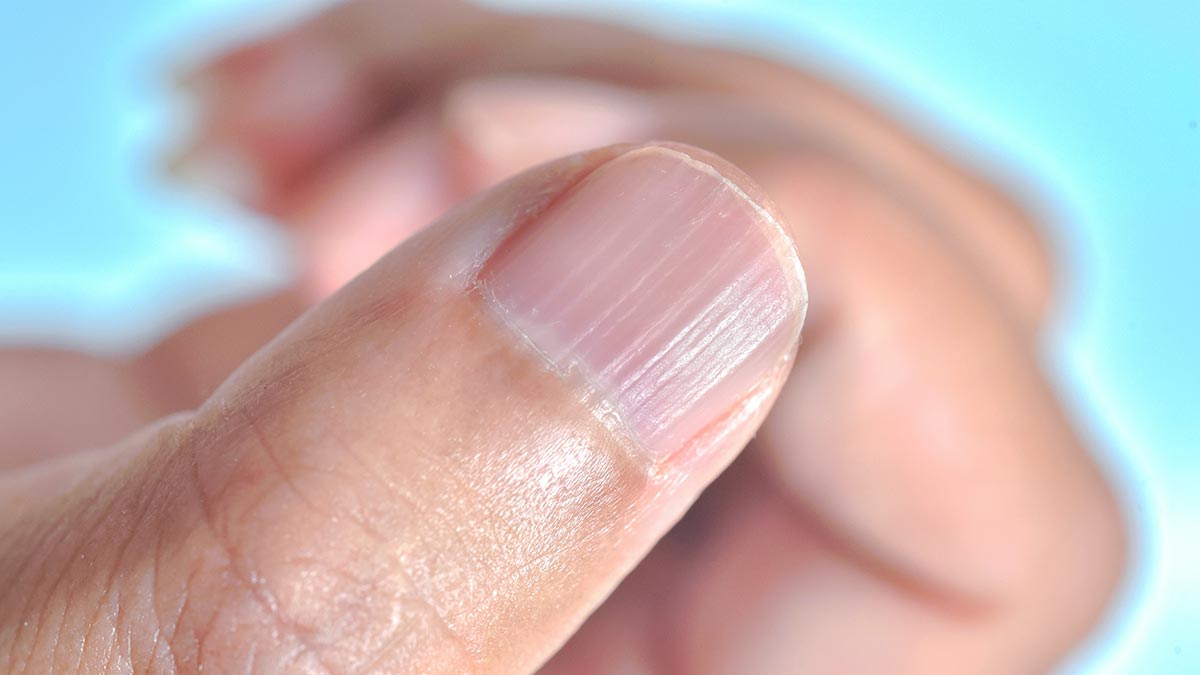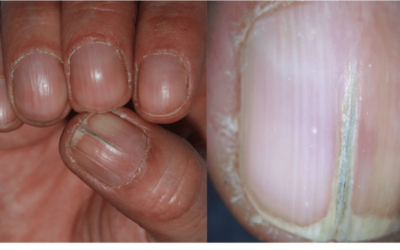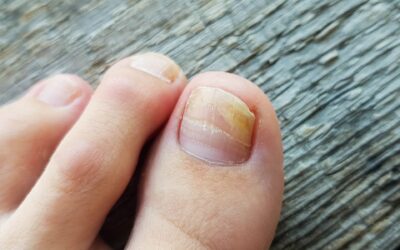Leukonychia—having one or more white nails —is a relatively common and mostly benign phenomenon. It can be caused by several things: a fungal infection, psoriasis, shock, or the result of another illness. Let’s take a look at these different causes, as well as possible treatments for removing white spots on fingernails and toenails and restoring a uniform pink color.

Credit Shutterstock
What is the normal color of the nail?
The nail has a small white part: the lunula, which is located at the junction between the nail and the cuticle. If you have long nails, the free edge, that is, the part of the nail that protrudes from the skin, is also white. This is an area that nail art fans like to highlight by adding white polish to the tips of the nails for an elegant French manicure. The rest of the nail is pale pink. The nail rests on the nail bed, a highly vascularized area. Its pink color shows through the nail.l The nail matrix is responsible for nail growth. It continuously produces layers of keratin that overlap. When the keratinocytes turn white, it is called leukonychia. This term simply refers to white spots on the nails.
White spots on nail. What are the possible causes?
White spots can have various causes. They can be caused by shock, a fungal infection, an allergy, or a symptom of another illness. Microtraumas to the nail matri.x Nail trauma is most often the cause of leukonychia. These microtraumas can occur for a variety of reasons, including a bump, a pinch, or a minor injury. They can also be caused by rough manicures: the back-and-forth motions of the file tend to damage the nail, as does pushing back the cuticles too roughly or biting your nailsOnIn the feet, trauma can come from overly long nails that hit the end of your shoe when walking.
To avoid these problems, remember to keep your toenails short. Choose cardboard files, which are less traumatic than metal ones, and always file your nails in the same direction. Choose quality manicure items and products, whether you prefer gel nails, acrylic nails, gel polish, or French manicures. These white spots are benign and only pose a cosmetic concern. They will disappear on their own as the nail grows or can be camouflaged by applying colored nail polish.
An allergy to products in contact with the nails
White nails can be a sign of an allergy to a product that comes into contact with the nails. The first things that come to mind are manicure products: nail polish, nail polish remover, false nails, gel nail kits, but cleaning products or other chemicals can also be the culprit. In this case, eliminating the allergen will allow your nails to return to normal.
Fungus, a common cause of nail spots
Mycosis refers to an infection caused by fungi – most often from the dermatophyte family. These colonize the skin or nails, on the hands or feet. Nail fungus is called onychomycosis Initially, a whitish or yellowish spot appears, which progresses over time. The nail becomes thicker, cracks, or crumbles. Fungal infection never heals spontaneously andrequires appropriate treatment. This treatment is all the more necessary because the infection can spread to neighboring nails or other members of the family!
Various products, such as nail polish, gel, or antifungal ointment, are available for sale. These treatments are often based on urea, an active ingredient poorly tolerated by sensitive skin. If you want to treat this infection naturally, you can turn to our Treatment for Nails Damaged by Fungal Infections. It contains more than 99% ingredients of natural origin. Among them are black Propolis, known to fight against nail damage, Plant Polyglycerides, which will fill the porosities, or even concentrated Terpineol. This is the active molecule of tea tree, which has the advantage of being 20 times more effective than the essential oil of the same name. It thus effectively fights against infections. This nail care has a brush tip. It is easy to apply daily to the gradient nail, even on the feet.
Leukonychia due to disease
Certain diseases or health problems affect the nails. They can cause a whitish color to all or part of the nail, or cause the appearance of white spots or lines. These include:
- Cirrhosis. In this case, the white marks appear more like horizontal lines;
- Kidney failure. The lower part of the nails turns white, while the upper part becomes more pink or pigmented;
- Heart failure;
- Psoriasis or diabetes;
- Some cancer treatments can also weaken the nail and change its appearance and structure.
Don’t panic, however, if you notice a white spot appearing on your fingernails or toenails. These spots aren’t the first sign of the aforementioned illnesses. They’re most often the result of an already diagnosed condition for which treatment is underway. However, they can guide or confirm your doctor’s diagnosis if you have other symptoms suggestive of these illnesses.
Can calcium deficiency cause white spots under the nails?
White spots under the nails are often linked, in the collective mind, to a calcium deficiency. Before you rush out to reach for cheese, let’s debunk this myth: calcium has nothing to do with all this. If you consume little dairy, you can increase your intake: it will still be beneficial for your body, but it won’t make those white spots disappear!
However, it’s worth noting that an unbalanced diet, with deficiencies in vitamins and minerals like iron, zinc, or silicon, can have various repercussions on the beauty and health of your nails. By prioritizing healthy and varied meals, you’ll put all the chances on your side to have beautiful nails.
White nails should you see a doctor?
Most of the time, having white nails isn’t a cause for concern. The white line or spot usually disappears as the nail grows back. However, you’ll need to be patient because nail regrowth is slow. It takes 3 to 6 months for fingernails to completely regenerate, and 12 to 18 months for toenails. Eventually, your nails will regain their pink color.
However, consulting a doctor should be considered if:
- The spot grows, or if the condition of the nail has deteriorated.
- White lines run across the entire nail.
- You are not sure whether it is a fungal infection or has persisted for several months despite the treatment given.
- Your nails have other abnormalities, such as waviness, peeling, or an area of swollen skin around the nail.
- The nail is painful.
- At the same time, you notice other symptoms that may indicate an illness. Your doctor will then prescribe appropriate tests to identify the illness and recommend the appropriate treatment.
Alvadiem, a specialist in natural nail care
We have developed a wide range of products to take care of your nails and your skin in general. Are your nails hard, brittle, and deformed? Discover our Treatment for Hard and Thick Nails, which restructures and smooths your nails. Are your nails struggling to grow, are they fragile, or do you bite them? Our Nail Strength and Growth Treatment is what you need. Complete your new beauty routine with our handfoot,t foot and body care products made in France, formulated with precious active ingredients from the hive. Our products are so gentle that they can be used on skin weakened by illness (diabetes, psoriasis) or oncological treatment. They are available for delivery or sale in partner pharmacies. Discover these natural treatments without delay, which have already won over thousands of users!




0 Comments